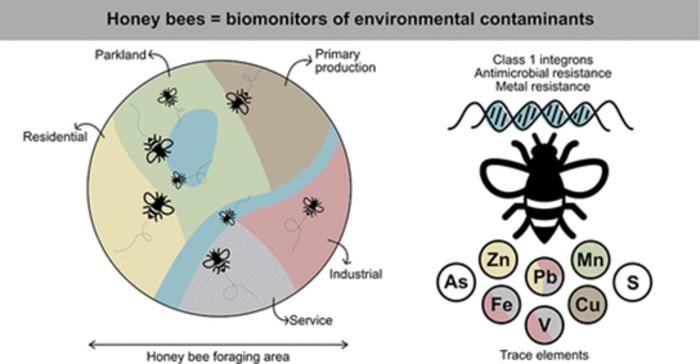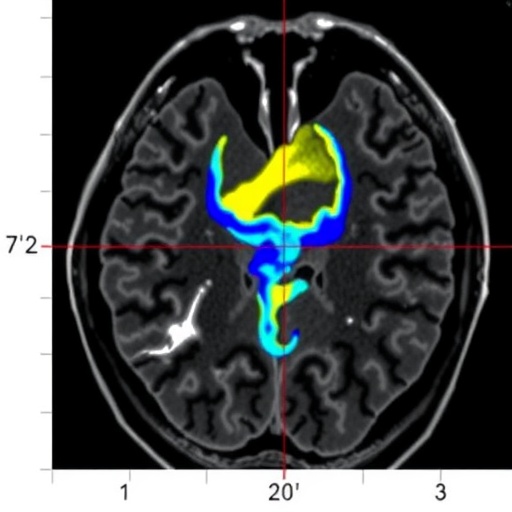Bees could become biomonitors, checking their neighbourhoods to determine how far antimicrobial resistance (AMR) has spread, according to research by Macquarie University scientists.

Credit: Fry et al 2023
Patrolling honey bees exposes spread of antimicrobial resistance
Insects prove their strength as environmental biomonitors
Bees could become biomonitors, checking their neighbourhoods to determine how far antimicrobial resistance (AMR) has spread, according to research by Macquarie University scientists.
At least 700,000 people die each year due to drug-resistant diseases, according to the World Health Organization (WHO), which estimates that 10 million people will die due to AMR by 2050. But we have few tools to keep track of its spread in the environment.
The study, published in Environmental Science and Technology, recruited honey bees, which can be a “crowdsourced” environmental proxy as they interact with contaminants in soil, dust, air, water and pollen while they forage.
“Bees interact with human environments, so they are a really good indicator of pollution that may present of risk of harm to humans,” says first author Kara Fry, an Adjunct Research Fellow at Macquarie University’s School of Natural Sciences and also Senior Research and Development Officer at the Environment Protection Authority Victoria (EPA).
“Bees only live for about four weeks, so whatever you’re seeing in a bee is something that is in the environment right now.”
Fry and lead author Professor Mark Taylor, who is the EPA Victoria Chief Environmental Scientist, examined 18 hives from citizen-scientist beekeepers who had hives across Greater Sydney in a mixture of land-use types.
She sampled eight bees from each hive to see what was in their digestive tracts.
Specifically, she was looking for genetic elements called Class 1 integrons, key drivers of resistance to antibiotics. She also looked for toxic metals such as lead.
“As humans have released their own bacteria into the environment, Class 1 integrons have spread into other natural systems. You can now find them on every continent, even Antarctica. You can find them in really diverse spaces,” Fry says.
The study found that more than 80 per cent of the bees sampled across all hives were positive for one or more antimicrobial resistance targets, surprising the researchers by showing that AMR is prevalent irrespective of the land-use context.
Fry and her team expected to find more integrons in more densely populated areas. Instead, they found them distributed over an extremely wide area but with higher concentrations around waterbodies such as dams and lakes.
“We suspect the presence of local waterbodies that collect run-off is a critical source of AMR contamination,” Fry says. “Everything from the catchment drains down, then it stays in that system.
“As anticipated, our study data showed that residential and industrial areas were impacted very heavily with environmental lead, with greater concentrations in more densely populated areas. By contrast, AMR was much more pervasive across the whole urban environment.”
While being able to monitor pollutants and determine where their concentrations are highest could provide an invaluable tool to understand where to implement clean-ups, the discovery of how widespread AMR is also provides a wake-up call for people to alter their behaviour.
“The main drivers of AMR are the misuse and overuse of antimicrobial products. The message from this research reinforces the need to use antibiotics when needed and as directed, and to dispose of them appropriately by returning unused medicines to your pharmacy,” Fry says.
“In addition, we should also take a look at the products we are using in our homes and avoid those with added antimicrobial agents.”
The researchers are now investigating the use of bees to detect other environmental contaminants as well as exploring whether certain bird species could be used in biomonitoring.
Read the full paper here.
Journal
Environmental Science & Technology
DOI
10.1021/acs.est.3c03775
Method of Research
Observational study
Subject of Research
Animals
Article Title
Tracing the Sources and Prevalence of Class 1 Integrons, Antimicrobial Resistance, and Trace Elements Using European Honey Bees
Article Publication Date
7-Jul-2023




